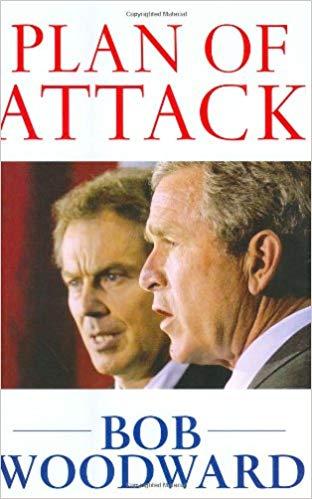Plan of Attack Summary – Bob Woodward

7 min read ⌚
 The Definitive Account of the Decision to Invade Iraq
The Definitive Account of the Decision to Invade Iraq
In “Bush at War,” Bob Woodward recounted George W. Bush’s responses to the 9/11 attacks and the subsequent War in Afghanistan.
Now, in “Plan of Attack” he picks up where he left off.
Which means – it’s time the American public learns of the decision-making process which led to the War in Iraq.
Who Should Read “Plan of Attack”? And Why?
Ever since blowing the Watergate affair wide open, Bob Woodward has acquired the status of a legend in the world of investigative journalism, which means that all of his books are both eagerly awaited and closely scrutinized.
This one was on the reading lists of both the Bush/Cheney and the Kerry/Edwards presidential campaign during the elections of 2004.
Which can only mean that is as objective and neutral-sided as it can be.
An essential read for everyone who wants to learn something more about the way our leaders decide who should we bomb and how should we do that.
 About Bob Woodward
About Bob Woodward
Bob Woodward is an American investigative journalist, an associate editor at “The Washington Post” where he has worked ever since 1971.
A 1965 graduate of Yale University, Woodward served as a communications officer in the US Navy for five years before beginning his journalistic career.
Just two years into it, he was teamed up with Carl Bernstein, and the two gained a nationwide reputation as the men who unearthed the Watergate Affair, “maybe the single greatest reporting effort of all time.”
An author of 17 nonfiction bestsellers and winner of two Pulitzer Prizes, Woodward has been described as both “the best reporter of our time” and “the best reporter of all time.”
Find out more at www.bobwoodward.com
“Plan of Attack PDF Summary”
Ten days before George W. Bush’s first inauguration, the newly elected American President attended a Pentagon briefing, which – following the advice of Vice President-elect (and behind-the-scenes, ahem, master of ceremonies) Dick Cheney – was supposed to be almost exclusively about Iraq.
Ever since the presidency of Bush’s father and the Persian Gulf War, Iraq was seen as a rogue state and its leader, Saddam Hussein, was regularly portrayed in American media as some sort of an incarnation of evil.
Be that as it may, the briefing must have been a boring affair, since Dick Cheney conspicuously nodded off, and George W. Bush was more interested in the peppermints on the table than what then-Secretary of Defense William Cohen had to say on the matter.
Donald H. Rumsfeld, on the other hand, couldn’t hear a thing, so he repeatedly kept asking the generals to speak up.
After the meeting, one of the chiefs dryly remarked that the new administration has gotten off to a great start.
In the eyes of Cohen, it seemed to be interested in everything but a war with Saddam.
A few days later, Bush received a second briefing.
This one was from George Tenet, Director of the CIA, and James Pavitt, his deputy.
The conclusions were unsurprising: there were three chief threats to the security of the United States, and none of them was Iraq.
Needless to say, the three threats in question were – in order of seriousness – Osama bin Laden, weapons of mass destruction (WMD), and China.
Nine months later, these predictions came through: 3,000 Americans lost their lives during the Al Qaeda-organized September 11 attacks.
Surprisingly, Bin Laden wasn’t the only target Pentagon was interested in after 9/11. That very same day, the then-Defense Secretary started plotting something else as well:
At 2:40 p.m. that day, with dust and smoke filling the operations center as he was trying to figure out what happened, Rumsfeld raised with his staff the possibility of going after Iraq as a response to the terrorist attacks, according to an aide’s notes. Saddam Hussein is S.H. in these notes, and UBL is Usama Bin Laden. The notes show that Rumsfeld had mused about whether to ‘hit S.H. @ same time — not only UBL’ and asked the Pentagon lawyer to talk to Paul Wolfowitz about the Iraq ‘connection with UBL.’ The next day in the inner circle of Bush’s war cabinet, Rumsfeld asked if the terrorist attacks did not present an ‘opportunity’ to launch against Iraq.
Four days later, during a debate at Camp David, even Dick Cheney – otherwise obsessed with attacking Iraq – advised against such an action: “If we go after Saddam Hussein,” he reportedly said, “we lose our rightful place as the good guy.”
Secretary of State Colin Powell didn’t want to hear anything about this: he saw no real linkage between Saddam and 9/11 and, unless provided, he considered any attempt to enlarge the scale of operations to include Iraq as well “a lunacy.”
What this resulted in was secret meetings between Donald Rumsfeld and his Deputy Paul Wolfowitz, culminating in a meeting between President Bush and Donald Rumsfeld during which it was effectively decided that the United States will invade Iraq.
This happened on November 21, 2001.
What followed was a “a chronicle of continual dilemmas, since the president was pursuing two simultaneous policies. He was planning for war, and he was conducting diplomacy to avoid war.”
Rumsfeld didn’t like any of the 68 war plans the Pentagon possessed concerning an invasion of Iraq, so he started a project of updating them.
Paul Wolfowitz and, especially, General Tommy Franks took care of that, and in about a year and a half, the United States was ready for a war.
One that it had about $700 million dollars to spend on (funds taken from the supplemental appropriations bill for Afghanistan), but no rationale to justify it (9/11 was not enough for the American public).
And, just like that, on February 5, 2003, Colin Powell (who changed his mind in the meantime possibly out of a sense of duty) addressed a plenary session of the United Nations Security Council and argued in favor of a military operation, claiming that Iraq possessed WMDs.
What the American public – and, most probably, Powell himself – didn’t know at that time, was that as much as half a year earlier, the CIA tried telling the Bush administration that Iraq wasn’t in possession of WMDs and that Saddam had never collaborated with Al Qaeda.
However, by that time, this didn’t matter one bit.
The Bush administration wanted Saddam out of Iraq, which was the only reason why the USA attacked the country.
As harsh as it may sound, the 9/11 attacks were just an appropriate excuse.
The real war – like most wars – was actually a secret one.
Key Lessons from “Plan of Attack”
1. The War on Terror Wasn’t About 9/11: It Was About Regime Change
2. The Planning of the Iraq War Started Way Before the American Public Found Out
3. The Pottery Barn Rule of War
The War on Terror Wasn’t About 9/11: It Was About Regime Change
As far as the official version of history is concerned, the War on Terror was United States’ response to the terrorist attacks of September 11.
However, this doesn’t explain why, that very same day, Donald Rumsfeld mused over “the possibility of going after Iraq as a response to the terrorist attacks.”
Iraq had nothing to do with the 9/11 attacks and, as we now know, it certainly didn’t possess WMDs.
However, it was ruled by Saddam Hussein, and he had to go.
That was all that mattered.
The Planning of the Iraq War Started Way Before the American Public Found Out
According to “Plan of Attack,” George W. Bush decided that the United States is going to attack Iraq on November 21, 2001, barely two months after the 9/11.
The rest of it – all the discussions about WMDs, and analyses of whether an invasion of Iraq was a feasible and reasonable solution – was nothing more but a smokescreen.
The Pottery Barn Rule of War
During the early period of the planning, Colin Powell was adamantly against a war in Iraq. He repeatedly warned the administration of “The Pottery Barn” rule of war.
Simply put, it states: “if you broke it, you owned it.”
In this case, it meant that an invasion of Iraq would result in the United States being subsequently responsible for all aspects of the country’s future fate.
Like this summary? We’d like to invite you to download our free 12 min app, for more amazing summaries and audiobooks.
“Plan of Attack Quotes”
Bush said he realized that the simple act of setting Rumsfeld in motion on Iraq war plans might be the first step in taking the nation to a war with Saddam Hussein. Share on X
The deep divisions and tensions in the war cabinet with Powell the moderate negotiator and Rumsfeld the hard-line activist meant no real policy would be made until either the president stepped in or events forced his hand. Share on X
Cheney became the self-appointed examiner of worst-case scenarios. Though it was not formalized, he would look at the darker side, the truly bad and terrifying scenarios… an ideal assignment for Cheney. Share on X
Cheney thought that the Clinton administration had failed in its response to terrorist acts, going back to the first World Trade Center bombing in 1993, and that there had been a pattern of weak responses. Share on X
Powell did not share Armitage’s concern that the two of them had been enablers of the Cheney-Rumsfeld hard-line policies. Share on X
Our Critical Review
Jill Abramson, the managing editor of “The New York Times,” described Woodward’s four books on George W. Bush as “the best record we will ever get of the events they cover.”
Preceded by “Bush at War” and followed by “State of Denial” and “The War Within,” “Plan of Attack” may be the most technical – and, thus, least interesting – one, but it is also the one covering the most crucial period of Bush’s presidency: the one between 9/11 and the invasion of Iraq.
Well-written and thoroughly researched, “Plan of Attack” is an exceptional and surprisingly impartial account of a still volatile topic.
As most of Woodward’s books – an essential read.


 About Bob Woodward
About Bob Woodward





